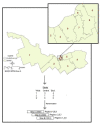Improved delivery of cardiovascular care (IDOCC) through outreach facilitation: study protocol and implementation details of a cluster randomized controlled trial in primary care
- PMID: 21952084
- PMCID: PMC3197547
- DOI: 10.1186/1748-5908-6-110
Improved delivery of cardiovascular care (IDOCC) through outreach facilitation: study protocol and implementation details of a cluster randomized controlled trial in primary care
Abstract
Background: There is a need to find innovative approaches for translating best practices for chronic disease care into daily primary care practice routines. Primary care plays a crucial role in the prevention and management of cardiovascular disease. There is, however, a substantive care gap, and many challenges exist in implementing evidence-based care. The Improved Delivery of Cardiovascular Care (IDOCC) project is a pragmatic trial designed to improve the delivery of evidence-based care for the prevention and management of cardiovascular disease in primary care practices using practice outreach facilitation.
Methods: The IDOCC project is a stepped-wedge cluster randomized control trial in which Practice Outreach Facilitators work with primary care practices to improve cardiovascular disease prevention and management for patients at highest risk. Primary care practices in a large health region in Eastern Ontario, Canada, were eligible to participate. The intervention consists of regular monthly meetings with the Practice Outreach Facilitator over a one- to two-year period. Starting with audit and feedback, consensus building, and goal setting, the practices are supported in changing practice behavior by incorporating chronic care model elements. These elements include (a) evidence-based decision support for providers, (b) delivery system redesign for practices, (c) enhanced self-management support tools provided to practices to help them engage patients, and (d) increased community resource linkages for practices to enhance referral of patients. The primary outcome is a composite score measured at the level of the patient to represent each practice's adherence to evidence-based guidelines for cardiovascular care. Qualitative analysis of the Practice Outreach Facilitators' written narratives of their ongoing practice interactions will be done. These textual analyses will add further insight into understanding critical factors impacting project implementation.
Discussion: This pragmatic, stepped-wedge randomized controlled trial with both quantitative and process evaluations demonstrates innovative methods of implementing large-scale quality improvement and evidence-based approaches to care delivery. This is the first Canadian study to examine the impact of a large-scale multifaceted cardiovascular quality-improvement program in primary care. It is anticipated that through the evaluation of IDOCC, we will demonstrate an effective, practical, and sustainable means of improving the cardiovascular health of patients across Canada.
Trial registration: ClinicalTrials.gov: NCT00574808.
Figures



References
-
- McManus B. CIHR Research: INTERHEART: Nine factors that could save your life. Healthcare Quarterly. 2005;8:28. - PubMed
-
- Yusuf S, Hawken S, Ounpuu S, Dans T, Avezum A, Lanas F, McQueen M, Budaj A, Pais P, Varigos J. et al.Effect of potentially modifiable risk factors associated with myocardial infarction in 52 countries (the INTERHEART study): case-control study. Lancet. 2004;364:937–952. doi: 10.1016/S0140-6736(04)17018-9. - DOI - PubMed
-
- Yusuf S, Hawken S, Ounpuu S, Bautista L, Franzosi MG, Commerford P, Lang CC, Rumboldt Z, Onen CL, Lisheng L. et al.Obesity and the risk of myocardial infarction in 27,000 participants from 52 countries: a case-control study. Lancet. 2005;366:1640–1649. doi: 10.1016/S0140-6736(05)67663-5. - DOI - PubMed
-
- Experiences with Primary Health Care in Canada. http://secure.cihi.ca/cihiweb/products/cse_phc_aib_en.pdf
-
- Institute for Clinical Evaluative Sciences. Study reveals the impact of not having a primary care physician. 2008. 2-8-2011.
Publication types
MeSH terms
Associated data
LinkOut - more resources
Full Text Sources
Medical
Miscellaneous

